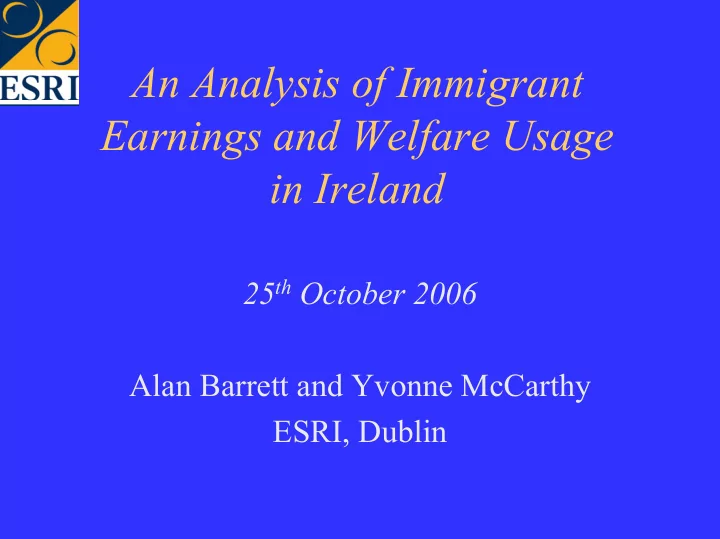

An Analysis of Immigrant Earnings and Welfare Usage in Ireland 25 th October 2006 Alan Barrett and Yvonne McCarthy ESRI, Dublin
Structure of the talk ♦ General motivation ♦ Literature ♦ Data and descriptives ♦ Earnings ♦ Welfare ♦ Summary and conclusions
General Motivation (1) - Net migration into Ireland, 1987-2006 Net migration (in thousands) 80 60 40 20 0 7 9 1 3 5 7 9 1 3 5 8 8 9 9 9 9 9 0 0 0 -20 9 9 9 9 9 9 9 0 0 0 1 1 1 1 1 1 1 2 2 2 -40 -60
General motivation (2) ♦ Why look at earnings? – previously we looked at occupation to measure labour market outcomes – earnings another measure – any gap raises questions about immigrant integration (discrimination/segmentation or lost productivity) ♦ Why look at welfare? – the public finance dimension
Literature ♦ Chiswick (1978) – convergence and overtaking – An initial earnings gap due to a lack of location- specific human capital; convergence as this is acquired; overtaking due to immigrant unobservables ♦ Borjas (1985) – the confusion of ageing and cohort effects – No convergence, just a changing national mix
Literature (contd.) ♦ Bell (1997) – different findings on wages for different immigrant groups in the UK ♦ Shields and Wheatley-Price (1998) – differences across immigrants and natives partly explained by where human capital was acquired ♦ Chiswick and Millar (2002), Dustmann and Fabbri (2003) – language ♦ McDonald and Worsnick (1998) – business cycle effects
Literature (contd.) ♦ On welfare participation ♦ Hansen and Lofstrom (2003) – differences in Sweden could not be fully explained by characteristics ♦ Riphahn (2004) – for Germany, characteristics did explain all the difference (unemployment and single parenthood)
Data ♦ Data source: EU-SILC ♦ Purpose of EU-SILC: To collect information on income and sources ♦ Sample Size: 5,477 households and 14,272 individuals ♦ Variables of interest: Age, education, labour force status, earnings, nationality, social welfare payments
Descriptive Statistics ♦ 2 main reasons for descriptive statistics: 1. To provide an overview of immigrants and natives in the sample 2. Compare EU-SILC immigrants to QNHS immigrants
Age Distribution of the Native and Immigrant Populations (%s) EU-SILC QNHS Age Group (yrs) Irish Immigrant Immigrant 0-14 22.0 15.8 22.6 15-19 7.9 3.7 5.9 20-24 6.3 8.9 9.9 25-34 9.4 25.5 32.3 35-44 12.5 18.5 19.6 45-54 13.2 13.4 4.3 55-59 6.1 4.5 1.6 60-64 5.2 2.7 1.9 65+ 17.5 6.9 1.9 Total 100.0 100.0 100.0 Mean 38.3 34.3 n/a N 13119 595 938
Work Status Distribution of Native and Immigrant Populations (%s) QNHS EU-SILC EU-SILC Immigrant Irish Immigrant Participation Rate 50.0 57.5 55.8 Unemployment Rate 5.1 6.3 8.4 N 10010 494 726
Distribution of Educational Attainment for the Native and Immigrant Populations (%s) QNHS EU-SILC Irish Immigrant Immigrant Less than Leaving Cert 35.7 14.1 9.4 Leaving Cert and Non-Degree 46.0 41.3 47.9 Third Level Degree and Above 18.3 44.6 42.7 Total 100.0 100.0 100.0 N 5092 269 361
Earnings ♦ Average gross earnings: - Irish born: €25.31 per hour - Immigrant: €17.05 per hour ♦ Mincer Type Equations ♦ Dependent Variable: Log of average gross hourly earnings ♦ Independent Variables: Immigrant Dummy, Gender, Experience, Education
Wage Regressions: Total Immigrants Coef. S. E Constant 1.85 0.03 Immigrant -0.18 0.04 Gender 0.12 0.02 Years 0.04 0 Worked (Years 0 0 Worked) 2 Leaving 0.31 0.02 Cert Third 0.85 0.03 Level N 3235 Total Immigrants = 183 Adj. R 2 = 0.28
Wage Regressions: English V Non-English Speaking Coef. S. E Immigrant: English -0.03 0.06 Speaking Country Immigrant: Non- -0.31 0.06 English Speaking Country N 3235 English Speaking = Non-English Adj. R 2 = 82 Speaking = 101 0.28
Wage Regressions: Non-English: EU-10, EU-13, rest Coef. S. E Non-English Speaking -0.45 0.12 EU-10 Non-English Speaking -0.27 0.11 EU-13 Non-English Speaking -0.27 0.08 Outside EU-25 EU-10 = 22 EU-13 = 27 Non-EU25 = 52
Wage regressions with interactions ♦ Part of the immigrant earnings disadvantage could be explained by different returns to human capital acquired in host and home countries ♦ Therefore including interaction terms between immigrants and education as well as immigrants and experience
Interaction: All Immigrants and Education Coef. S. E Immigrant -0.12 0.06 Immigrant*Third Level -0.17 0.09
Social Welfare ♦ Social Welfare usage defined here as receipt of unemployment or disability benefit or assistance at any time over the previous 12 months ♦ Sample shows 15% of native adult population receiving Social Welfare as compared to 7% for immigrants ♦ Are immigrants more or less likely to use Social Welfare than natives? – Probit Analysis
Probit Results Marginal P>|z| Marginal P>|z| I I Immigrant -0.05 0.01 Immigrant: English -0.06 0.03 Speaking Country Immigrant: Non- -0.04 0.16 English Speaking Country
Conclusions ♦ Immigrant hourly earnings are 18% lower than those of native employees ♦ The gap is much more pronounced for immigrants from non-English speaking countries (3% versus 31%) ♦ Within the non-English speaking countries, we find an hourly earnings disadvantage of 45% for EU-10, 27% for EU-13 and 27% for rest of non-English-speaking ♦ English fluency appears to be a crucial determinant of immigrant labour market success in Ireland ♦ Returns to third level degrees seem to differ
Conclusions (contd.) ♦ On average immigrants use welfare services less intensively than natives ♦ Difference remains even when we adjust for the higher levels of education among the immigrant population ♦ This suggests that immigrants are not putting a disproportional demand on this element of the public finances ♦ Dynamic element missing
Recommend
More recommend